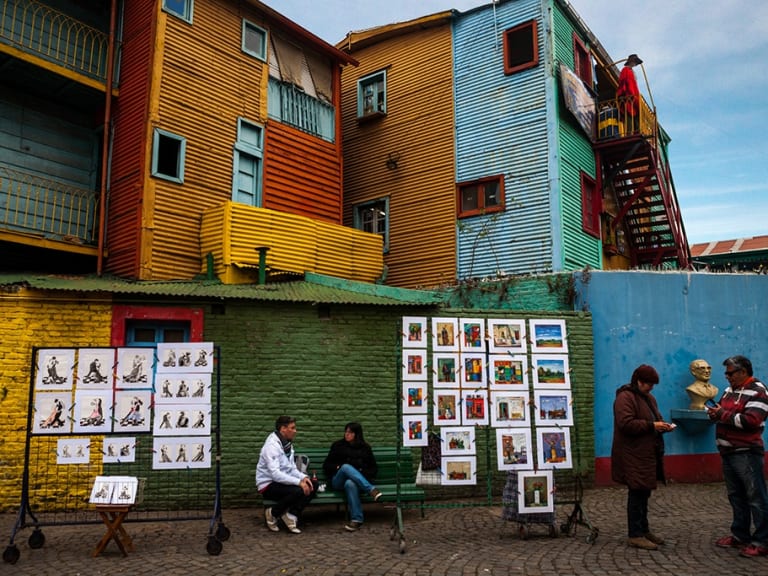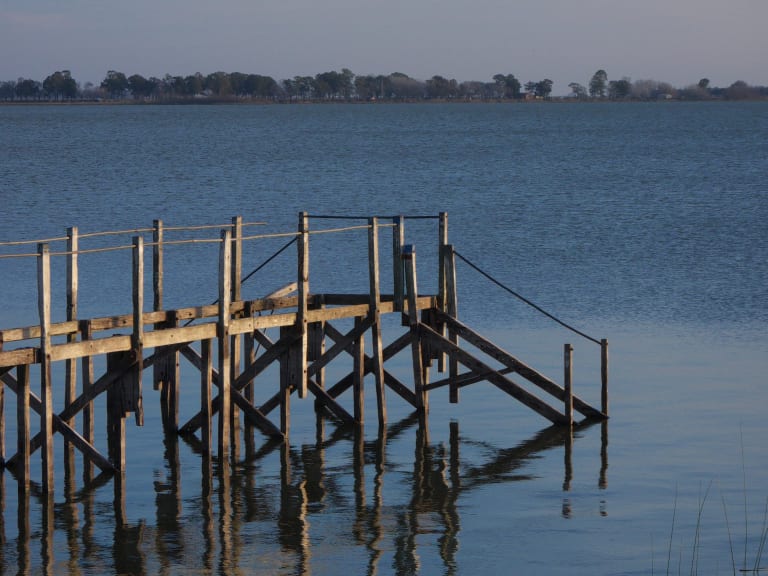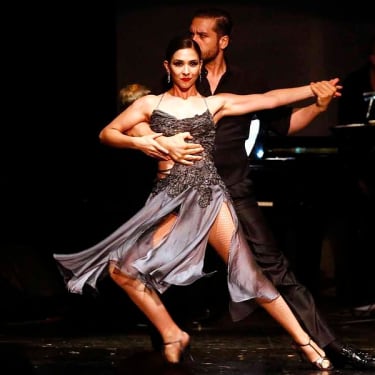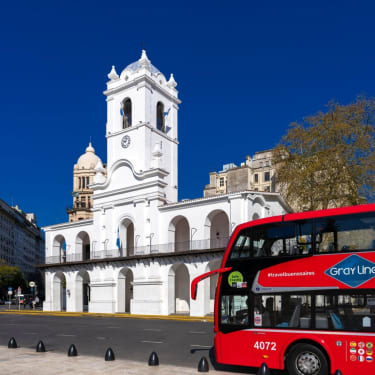More about: Buenos Aires in 7 Days: a guidebook for getting the most out of your visit
There are many things to see and do in Buenos Aires, as it is a vibrant city, full of life and culture and worth exploring with time. Touring its historic centre, exploring its different neighbourhoods, visiting museums, attending concerts or learning one of the most sensual dances in the world, the tango, are some of the things that the capital of Buenos Aires has to offer.
In addition, in Buenos Aires you have many green spaces to explore, such as parks, gardens, coastal walks and an ecological reserve; nearby towns where you can spend a day in the countryside and the possibility of visiting the fifth largest delta in the world, the Tigre delta. There are so many proposals that I have organised them in 7 days, so you won't miss anything during your stay in Buenos Aires.
Day 1: Explore downtown Buenos Aires and the neighbourhood of San Telmo

On your first day in CABA you can explore the city centre, where you will find the most emblematic buildings of Buenos Aires, and then visit the neighbourhood of San Telmo, to finish the day in one of its traditional milongas, and why not, take a tango lesson.
A very comfortable way to get around the centre is to take a tourist bus around Buenos Aires, as it has stops at the main places of interest and you can get on and off as many times as you want.
Downtown Buenos Aires
The tour that I propose you through the city centre, which is part of some of the best tours in Buenos Aires, starts at the Colón Theatre, continues at the Obelisk (which is two blocks away) and arrives at the Plaza del Congreso (1,5 km away). From there you can walk along Av. de Mayo, and pass by the Barolo Palace and the Café Tortoni, before ending at the historic Plaza de Mayo.
The route would be as follows:
-
- Teatro Colon: due to its acoustics it is considered one of the best opera theatres in the world, where you can take an interesting guided tour or get tickets to the theatre to tour it on your own.
-
- Obelisk: it is the iconic monument of the city, which was built to commemorate the fourth centenary of the foundation of Buenos Aires.
-
- Barolo Palace: it is a building inspired in Dante's Divine Comedy, highly recommended for a guided tour.
-
- Café Tortoni, located three blocks away from Plaza de Mayo, is the oldest café in Buenos Aires (1858), where an important literary peña used to function until 1926, and where Carlos Gardel used to go.
-
- Plaza de Mayo: it is one of the most emblematic squares in the country, renowned for the Rondas de las Madres de Plaza de Mayo that have been held since 1977. In its surroundings you will find the Casa Rosada (seat of government) and the Buenos Aires Cathedral.
From Plaza de Mayo, you can reach San Telmo by bus in about 15 minutes.
The neighbourhood of San Telmo
Two kilometres from Plaza de Mayo is the neighbourhood of San Telmo, one of the oldest and most picturesque in the city. It is known for its bohemian atmosphere and the San Telmo Fair, which takes place every Sunday in Plaza Dorrego.
In this square you will find the Plaza Dorrego bar, which has been declared an Asset of National Historic Interest, since it is where two well-known Argentinean writers used to meet: Borges and Sábato. Nearby is the Paseo de la Historieta, where you will see sculptures of Mafalda and other characters from Quino's classic comic strip.
The San Telmo neighbourhood is also the place to visit some of the city's most traditional milongas and see the best tango shows in Buenos Aires. You can even take a tango lesson, as they usually take place around 7 or 8 pm.
One of the most traditional bars in San Telmo to see tango shows and have dinner is El Querandí, a place declared of tourist interest that is housed in an old 1920's mansion.
Day 2: Discover Barrio Palermo by day and night

Your second day in Buenos Aires can be spent exploring the Palermo neighbourhood, which is about 5 km from the Obelisk, and can be reached very quickly by taking the underground (metro). There are many things to see and do in Palermo-Buenos Aires, such as visiting its green spaces and museums, or enjoying its lively nightlife.
I suggest you to visit Tres de Febrero Park, also known as Bosques de Palermo, the largest park in the city with 370 hectares, during the day. There you can visit the Japanese Garden, the Rose Garden, the Botanical Garden of the city, the Planetarium, lakes and several museums: the Museum of Plastic Arts Eduardo Sivori, the Museum of Latin American Art and the Evita Museum; so it will take you the whole day.
It is an ideal park if you visit Buenos Aires with children, because of all the recreational and outdoor activities it offers.
Carlos Thays Botanical Garden
The Carlos Thays Botanical Garden is a very beautiful park dedicated mostly to native flora, and also to plants from different parts of the world. There you can take 5 different thematic tours, sign up for workshops and visit a butterfly garden.
- Opening hours: Tuesdays to Fridays from 8am to 6pm; Saturdays, Sundays and holidays from 9.30am to 6pm. From September to March the opening hours are extended by one hour.
- Admission: free of charge.
Japanese Garden
The Japanese Garden is a beautiful garden with ponds, sculptures, bridges, monuments, flowers and bonsais, built by the Japanese community in 1967. It also has a Culinary Art Space where you can taste typical Japanese food.
- Opening hours: every day from 10 am to 6.45 pm approximately.
- Entrance fee: about 2 EUR.
Evita Museum
If you want to learn more about the history and culture of Argentina, at the Evita Museum you will find a lot of information about the legacy of Eva Duarte de Perón, or Evita, as she is known in the country. There you will see objects of the time, film materials and even dresses of the first lady who promoted women's suffrage and won the hearts of Argentines for her important social work.
- Location: Lafinur 2988 - CABA
- Hours: Tuesdays to Sundays from 11am to 7pm, except holidays.
- Admission: free.
Palermo neighbourhood at night
Palermo is also known for its nightlife, particularly in the area known as Palermo Soho, which is in the surroundings of Plaza Serrano, and Palermo Hollywood, which is located between Gorriti and Honduras streets. There you will find the best things to do in Buenos Aires at night, as it is an area full of bars, restaurants and nightclubs, very popular among young people.
Day 3: Get to know the mystique of Recoleta neighbourhood

The Recoleta neighbourhood is located next to the Palermo neighbourhood, about 3 km from the Obelisk, and can be reached by bus or underground from downtown in about 10 minutes. It really is so close to Palermo that you could see both neighbourhoods in one day. However, as there are many interesting things to do in Recoleta, it is best to dedicate a day to each neighbourhood.
In the morning you can go to the Recoleta Cemetery, considered an open-air museum, and after lunch, to the National Museum of Fine Arts (MALBA), one of the most important museums in Latin America. Very close to this museum is the sculpture Floralis Genérica, in the United Nations Park.
In the afternoon, I suggest you go to the Centro Cultural Recoleta, where you can explore its exhibitions and participate in the cultural activities, which are open until 10pm. Recoleta is also home to the National Library and the famous El Ateneo bookstore, the largest in Latin America.
It is a neighbourhood with many green spaces, and one of the most opulent in Buenos Aires, with many cafes and restaurants where you can eat typical local dishes.
Recoleta Cemetery
A visit to the Recoleta Cemetery is a classic in the city, because apart from the architectural and sculptural works that you can admire, you learn a lot about the history and culture of the country. It was built in 1822, and is the oldest cemetery in Buenos Aires.
It is very popular because it contains the tombs of artists, presidents and important political figures of the country, such as Juan Domingo Perón, Alfonsín and Evita. The guided tours are very interesting, as they also tell you about the mysteries and legends of the city.
- Location: Junín 1760 - CABA
- Hours: Monday to Sunday from 9 am to 5 pm.
- Entrance fee: around 6 EUR and 3 EUR on Wednesdays.
MALBA
One of the most important museums in Buenos Aires and Latin America, it houses works by renowned artists such as Xul Solar, El Greco, Berni, Picasso, Goya and Spilimbergo, among others, as well as art collections of native peoples.
Touring MALBA can take you an hour and a half or two, depending on your personal interest in art.
- Location: Av. Figueroa Alcorta 3415 - CABA
- Opening hours: Thursday to Monday from 12 to 20 hs, and Wednesday from 11 to 20 hs. Closed on Tuesdays.
- Admission: around 6 EUR and 3 EUR on Wednesdays.
El Ateneo Grand Splendid Bookshop
The El Ateneo bookshop is a very popular bookshop in the city, not only because it is the largest in South America, but also because it is housed in a building from the beginning of the 20th century, which is very interesting in itself, with a 20-metre diameter dome decorated with frescoes. Inside there is also a cafeteria.
- Location: Santa Fe 1860 - CABA
- Opening hours: Monday to Saturday from 10am to 7pm, and Sundays from 12pm to 7pm.
Day 4: Get to know Puerto Madero and its ecological reserve

The Puerto Madero neighbourhood is located about 500 metres from the Plaza de Mayo, and a few metres from the Casa Rosada. It is an area with green spaces next to the pier, promenades, sculptures and bridges, ideal to walk around and spend a day in contact with nature.
There are also museums, such as the Corbeta Uruguay Museum Ship, the Museum of Decals and the modern art museum of Amalia Lacroze de Fortabat.
I recommend you to visit the museums in the morning and walk along the pier, where you can see the sculpture of the Bridge of the Woman. After lunch, you can visit the Ecological Reserve on the banks of the Río de la Plata, and get to know the native biodiversity. In the evening, you can choose a menu from the food trucks set up along the waterfront, or go to a local restaurant.
Women's Bridge
The Puente de la Mujer (Women's Bridge) represents a couple dancing tango, and is an emblem of the neighbourhood. More precisely, it is a rotating bridge that moves to let the boats sailing in the dock pass, a work of the architect Santiago Calatrava.
Corbeta Uruguay Museum Ship
The Corbeta Uruguay Museum Ship is the oldest ship still afloat in the country. It was built in 1874 and for some years operated as a training ship. It can be visited from Thursday to Sunday.
- Opening hours: Thursdays and Fridays from 1pm to 7pm, and Saturdays and Sundays from 10am to 7pm.
Costanera Sur Ecological Reserve
The Reserva Ecológica Costanera Sur is a wetland covering some 350 hectares, where you can see native animals and plants. It is considered a Ramsar site, i.e. a wetland of great ecological importance. There you can see more than 2,000 native species, and some 350 species of birds, and walk along different trails.
La Reserva offers different free activities that you can join, so I recommend that before you go you visit the website of the reserve, to know all its proposals.
- Opening hours: Tuesdays to Sundays from 8am to 6pm approximately, and in summer until 7pm.
- Entrance fee: free of charge.
Day 5: Visit El Tigre and one of the largest deltas in the world

On your fifth day in Buenos Aires you can take a day trip to Tigre, a city about 32 km away. From there you can visit the Delta del Tigre, which is a real maze of rivers and islands with an enormous biodiversity.
It's best to explore the Tigre Delta by boat or kayak to see the native flora and fauna of the region, but you can also spend the day at a beach resort or take a guided tour of different trails. From Tigre you can also go by boat to Martín García Island, a wetland nature reserve located at the confluence of the Uruguay River and the Río de la Plata.
When you return from your tour of the Delta, you can walk along the Paseo Victorica, which is located on the banks of the Luján River and, if you wish, visit the Naval Museum and/or the Tigre Art Museum. You can also go to the Mercado de Frutos (Fruit Market), where you can find a wide variety of handicrafts and food stalls.
Another possibility if you go to Tigre with children are the playgrounds, such as the Parque Aéreo Euca Tigre, which has about 100 high rides of varying difficulty for children and adults, and the Parque de la Costa, the largest amusement park in the country.
How to get to Tigre
To get there from CABA you have several options, apart from going by car:
- The Mitre line train Ramal Tigre at Retiro train station, which leaves every 15 minutes from 5am to 11am. It arrives in approximately one hour.
- The Tren de la Costa, which has a more touristic route, but first you have to take the train of the Mitre Ramal Mitre line and then this train.
- UncolectivoUrbano (bus), which takes an hour and a half to get there.
- Hire an excursion with transfer, which will surely include different activities to do in the city and in the Delta del Tigre.
Whether you take a bus or a train, you will need to buy and credit your SUBE card, which you can do at any underground or train station.
Day 6: Tour one of the most football-loving neighbourhoods: La Boca neighbourhood

After spending a day in nature in the Tigre Delta, you can spend a day in the La Boca neighbourhood, where you will find the famous Boca Juniors football stadium, known as La Bombonera, and the Caminito Museum Street, a very picturesque street with street art worth seeing.
In the morning you can visit the stadium, and then walk about 4 blocks to Caminito Street. Near this street you will find the Quinquela Martin Art Museum, the Wax Museum, and the Museum of Contemporary Art La Boca, among which you can choose according to your interest.
In the afternoon you can finish your tour at the Usina del Arte, a cultural centre that has interesting proposals every day and is located one km away from the stadium. On the way you can see the mysterious Torre del Fantasma, which is 5 blocks away from La Bombonera, although it is not possible to enter.
Be aware that the neighbourhood of La Boca is not one of the safest in Buenos Aires, so it is better not to stay there until very late.
Boca Juniors football stadium
Visiting La Bombonera is a must for football lovers, as well as being one of the most important football teams in the country, it is where Diego Armando Maradona made his debut in the First Division, playing for Argentinos Juniors.
During your visit, you can visit both the stadium and the Museum of Boquense passion. Here you can see different objects, shirts, audiovisual material and trophies related to the club's history. You also have the option of hiring a guided tour to learn all about the history of this team and Argentinean football.
- Location: Brandsen 805, CABA
- Opening hours: Monday to Sunday from 10am to 6pm approximately. Ticket office closes at 17.30 hs.
- Ticket price: around 6 EUR.
Caminito Museum Street
Caminito Museum Street is the most colourful street in Buenos Aires, where you can enjoy amazing street art. It is about 150 metres long and its buildings, former tenement houses, are home to art workshops and craft shops.
Also, all over La Boca neighbourhood you will see fileteado, an art form that was born in Buenos Aires, with curved shapes and bright colours. If you have a special interest in this type of art, you could sign up for one of the graffiti tours that take place in Buenos Aires.
La Usina del Arte
La Usina del Arte is a cultural centre where every weekend there are free events such as concerts, exhibitions, children's activities and workshops, so it is a good option for you to explore in the afternoon in La Boca. Also, the acoustics of the auditorium are not to be missed.
The building itself is worth seeing, as the cultural centre is housed in an old English-style power plant. If you have time, you can also visit the Pablo Ducrós Hicken Cinema Museum, which is next door.
- Location: Agustín R. Caffarena 1, CABA. La Boca neighbourhood.
- Opening hours: Fridays from 3pm to 8pm, and Saturdays and Sundays from 11am to 8pm.
Day 7: Spend a day in the countryside in a typical village

On your last day in Buenos Aires you can take a trip to one of the more typical villages in the outskirts of the city, to get to know the countryside and take away a bit of the gaucho spirit they try to preserve. An interesting way to get to know it is by taking a gaucho tour in Buenos Aires.
Some of the towns you can visit are San Antonio de Areco, 120 km from Buenos Aires; San Antonio de Giles, 100 km from the city and Chascomús, located 120 km away, and famous for its homonymous lagoon. From Buenos Aires you can reach any of these towns by bus in about two hours.
In these small towns you can visit ranches, "pulperías", gaucho museums, old chapels, handicraft markets and walk through quiet streets far from the hustle and bustle of the capital. You will also be able to eat typical food such as asado al asador in the most traditional restaurants.
This is the end of the itinerary that I propose to you to visit Buenos Aires in 7 days, and get to know the most characteristic features of the city during your stay. An extra is to take a day trip to Montevideo, the capital of Uruguay, which is about 3 hours away from the city and can be reached by ferry.




